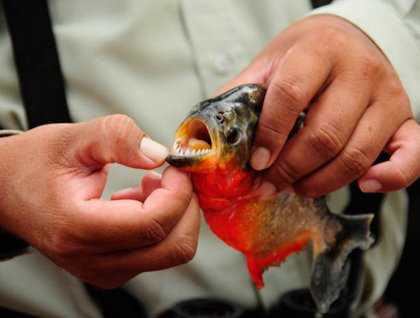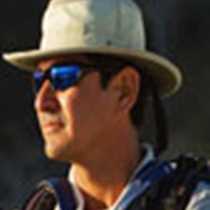After grabbing a quick coffee we boarded our skiffs and headed out at our usual early morning time of 6:00. Our goal was to see if we could find the big blue and yellow macaws before they left their roosting area to forage in the forest for the day. We found where they roosted overnight and we were lucky enough to see several perched up in the treetops. They are truly fabulous birds to see and so big and beautiful in the morning light. Scores of white-eyed parakeets had also roosted in the same area and were just leaving flying out in small groups to forage. What a fabulous ruckus all these birds made!
Next we went in search of the pygmy marmoset, the smallest monkey here. They bite the Inga trees and suck the sap. We walked through an orchard scanning the appropriate trees until we found them. They were so tiny and cute. We could have fit them in our pocket.
After breakfast, we headed back out if the skiffs. We turned off the Ucayali River and headed up a small tributary called Belluda Cano. The tributary was about 20 feet wide and offered us wonderful personal glimpses of the forest and wildlife. The solitude and peacefulness of drifting along the creek, observing and listening to the forest noises, makes man’s outside world seem so far away and meaningless. Life doesn’t get much better than this.
As our skiff slipped into the forest, we observed a tree with a hole overhead from which three cute faces were peeking down. These were a group of night monkeys, the only genuinely nocturnal monkeys. They have a cute owl-like rounded head with immense dark eyes surrounded by white fur, all a good indicator of the creature’s nocturnal way of life. The three monkeys spend their daytime hours cuddled together in this hollow tree hole. At night they forage anywhere from the forest floor to the canopy eating fruits, buds, insects, and flower nectar. These three were very inquisitive and brave, peering down and watching us while we watched back. What a special opportunity to see these nocturnal mammals.
An after-lunch siesta was longer than usual as we left at 4 p.m. to head up the Rio Dorado for a long excursion returning after dark. Shortly after starting our skiff ride it started to rain. This was our first excursion with rain, and it was great to experience it giving us a true feel of life in the rain forest.
As the light faded we used a big spotlight to see nocturnal wildlife. The transition from day to night is an amazing time to see the wildlife transition along the river. There were night jars or night hawks called pauraques that eat insects, and a relative of these called the common potoo, a much larger owl-size insect eater. Fishing bats were flying up and down the creek, echo locating for fish off the ripples fish make as they come to the surface to catch insects. We also found small spectacled caimans along the bank. These are the most common caiman in South America and a member of the alligator family. We also stopped to see the odd-looking boat-billed heron, a nocturnal bird with an amazingly big bill shaped like a rowboat. The entire experience was great and everyone came home thrilled at having watched the nocturnal environment unfold.









